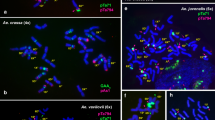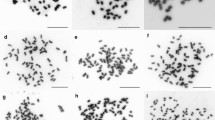The cytology of thirteen taxa and two hybrids in the genus Pennisetum indicated the distribution of the taxa among the four basic chromosome numbers 5, 7, 8 and 9. The diploid nature of P. ramosum and P. typhoides and the genomic allotetraploid status of P. purpureum was further confirmed. P. massaicum (2n=32), P. orientale (2n=36) and P. subangustum (2n=36) suggested probable autotetraploid nature and the three hexaploids (2n=54) investigated (P. polystachyon, P. longistylis and P. squamulatum) revealed allohexaploid constitution. The natural triploid, P. ruppellii (2n=27) and pentaploid P. villosum (2n=45) were found to be apomicts and they were allotriploid and allopentaploid respectively. The tetraploid-hexaploid complex of P. pedicellatum showed them to be cytotypes only. The cytogenetical behaviour of the hybrid, P. typhoides x P. purpureum with 2n=21 and the trispecies hybrid (P. typhoides x P. purpureum) x P. squamulatum with 2n=48 brought out the homology within the genomes of x=7 and x=9 and also between the genomes with x=7 and x=9. The significance of the inter- and intragenomic chromosome pairing had been brought out from the interspecific hybrids and the natural allotriploid and allopentaploid species having one genome in the haploid condition.
The morphological sections of this genus did not correspond with the cytological groups. A high degree of evolutionary specialization was evident in species of the section Gymnothrix. A complete series of polyploids and high degree of heterogeneity from the morphological point of view was brought out in species with x=9.
Similar content being viewed by others
References
Avdulov, N. P. (1931). Karyo-systematische Untersuchung der Familie Graminen. Trudy prike. Bot. genet. Selek. 44 (Suppl.).
Bashaw, E. C. & E. C. Holt (1958). Megasporogenesis, embryosac development and embryogenesis in Dallisgrass, Paspalum dilatatum. Agron. J. 50: 753–756.
Brown, W. V. & W. H. P. Emery (1957). Apomixis in the Gramineae: Tribe Andropogoneae: Themeda triandra and Bothriochloa ischaemum. Bot. Gaz. 118: 246–253.
Hrishi, N. J. (1952). Studies on the cytogenetics of six species of Pennisetums and their comparative morphology and anatomy. Genetica 26: 280–356.
Jauhar, P. P. (1968). Inter and intragenomal chromosome pairing in an interspecific hybrid and its bearing on basic chromosome number in Pennisetum. Genetica 39: 360–370.
Jones, K. (1962). Chromosomal exchange and evolution in Dactylis. 2. The chromosomal analysis of diploid, tetraploid and hexaploid species and hybrids. Genetica 32: 272–295.
Jones, K. & M. Borril (1962). Chromosomal status, gene exchange and evolution in Dactylis. 3. The role of interploid hybrids. Genetica 32: 296–322.
Krishnaswamy, N. & V. S. Raman (1951). Cytogenetical studies of the interspecific hybrid of Pennisetum typhoides Stapf and Hubb. x P. purpureum Scum. Proc. 1st Sci. Workers' Conf., Madras, pp. 47–71.
Krishnaswamy, N. & V. S. Raman (1953). Studies on the interspecific hybrids of Pennisetum typhoides x P. purpureum. II. Cytogenetics of 22 chromosomed F2 plants. Cytologia 18: 305–321.
McWilliam, J. R. & C. A. N. Smith (1962). Tetraploid and hexaploid chromosome races of Phalaris arundinacea. Aust. J. agric. Res. 13: 1–13.
Muntzing, A. (1937). The effects of chromosomal variation in Dactylis. Hereditas 23: 113–225.
Muntzing, A. (1954). Cytological basis for polymorphiam in Poa. Hereditas 40: 459–510.
Myers, W. M. (1947). Cytology and genetics of forage grasses. Bot. Rev. 13: 319–421.
Narayan, K. N. (1951). Cytogeneties of apomixis in Pennisetum. Thesis, Univ. of California.
Narayan, K. N. (1961). Cited by K. Subramanyam, 1961, Sumposium on plant embryology, apomixis and polyembryony. J. Sci. Indust. Res. 20: 477–483.
Patil, B. D. & Amar, Singh (1964). An interspecific cross in the genus Pennisetum involving two basic chromosome numbers. Curv. Sci. 33: 256.
Patil, B. D., N. W. Hardas & A. B. Joshi (1961). Autoalloploid nature of Pennisetum squamulatum. Nature 178: 1241–1242.
Patil, B. D., N. W. Hardas, K. P. O. Connor & S. K. Vohra (1962). Polyploidy in Pennisetum orientale Rich. Curr. Sci. 31: 161–162.
Raman, V. S., M. K. Nair & D. Krishnasami (1962). The cytology of Pennisetum ruppellii-A reinvestigation. J. Ind. bot. Soc. 41: 243–246.
Smith, B. W. (1948). Hybridity and apomixis in the perennial grass Paspalum dilatatum. Genetics 33: 628–629.
Snyder, L. A. (1953). A cytological study of Bouteloa gracilis from Texas and Eastern New Mexico. Am. J. Bot., 40: 702–707.
Sree Rangasamy, S. R. & B. W. X. Ponnaiya (1963). A trispecific hybrid in Pennisetum (P. typhoides x P. purpureum) x P. squamulatum. Madras agric. J. 50: 239–241.
Stapf, O. (1934). Flora of Tropical Africa. Reeve, Kent.
Stedbins, G. L. (1956). Cytogenetics and evolution of the grass family. Am. J. Bot. 43: 890–905.
Author information
Authors and Affiliations
Rights and permissions
About this article
Cite this article
Sree Rangasamy, S.R. Cytological studies on diploid and polyploid taxa of the genus Pennisetum Rich. Genetica 43, 257–273 (1972). https://doi.org/10.1007/BF00123633
Received:
Accepted:
Issue Date:
DOI: https://doi.org/10.1007/BF00123633




